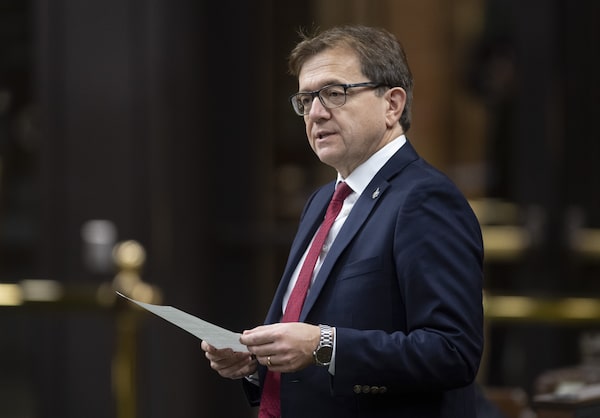
Environment and Climate Change Minister Jonathan Wilkinson responds to a question during Question Period in the House of Commons Nov. 19, 2020 in Ottawa.Adrian Wyld/The Canadian Press
The federal government says 2019 was the last year for increases to greenhouse gas emissions in Canada and the country will start recording a decline for 2020.
But as Canada confirmed Monday that emissions increased in 2019 for the third year in a row, the latest promise from Prime Minister Justin Trudeau’s government was met with incredulity from the opposition. The National Inventory Report shows Canada has cut emissions by just 1 per cent below 2005 levels, as of 2019, leaving it a significant distance from its Paris Agreement pledge to cut output by 30 per cent below 2005 levels by 2030.
In 2019, emissions went up by two megatonnes to 730 megatonnes.
B.C. is first province in Canada to set emissions targets for industries, communities
Canadian Natural Resources and Cenovus plan new emissions targets, no shift to renewables
Which Canadian companies have pledged net zero carbon emissions, and by when?
“We will see year-on-year reductions – absolute reductions – starting in 2020, through to 2030,” Environment Minister Jonathan Wilkinson said in an interview with The Globe and Mail on Monday. “... We have high confidence that’s actually going to be the case.“
Canada’s emissions reporting lags by more than a year. Mr. Wilkinson said the 2019 emissions are also lower than what baseline projections from 2016 showed would happen by 2019 if the government hadn’t imposed its climate plans, which include carbon pricing.
Canada has never met any of its emissions reduction targets, but the Liberals promise to end that habit.
NDP MP Laurel Collins said the Liberals have shown that they can make promises but don’t know how to deliver on them. “They were elected in 2015, their emissions have increased. Only in some kind of upside down, Liberal double-speak world could that be considered on track,” she said.
The Conservatives criticized the continued increase in emissions under the Liberals. Leader Erin O’Toole has promised to cut the federal carbon system, but has not yet revealed his party’s climate plan to show how else it would cut emissions.
Still, before the country starts recording a downward trend in emissions, Mr. Trudeau will set the bar even higher when his government announces new 2030 targets. Mr. Wilkinson said the targets will be released either before or at a summit with U.S. President Joe Biden, which takes place on April 22 and 23.
Before that, the Liberals will table their April 19 budget. The Environment Minister kept expectations for new climate-related measures low and played down the need for Canada to invest heavily after the Americans announced a US$2-trillion infrastructure program that includes significant green investments.
“The Americans in that respect, I think are sort of moving to where we are already,” Mr. Wilkinson said. He said that Canada has already invested in zero-emissions vehicles and in decarbonizing the electricity grid.
The highest emitting sectors in Canada (oil and gas and transportation) are the ones that Mr. Wilkinson said he will be most focused on in the years ahead. On transportation, Mr. Wilkinson said emissions can largely be cut through regulatory changes that will target vehicle fuel efficiency. He said in his talks with Mr. Biden’s special envoy for climate, John Kerry, the focus is on “how fast can we go in terms of raising the level of ambition” on fuel economy standards.
More investments in zero-emission vehicle infrastructure will also be needed, he said.
On the oil and gas sector, Mr. Wilkinson said the increasing stringency of methane regulations will “start to bite” and the pending implementation of the clean fuel standard will also have a “significant impact on emissions.”
Raising the carbon price to $170 a tonne by 2030 is the key reason why Canada can show that it will meet its emissions targets in less than a decade.
Catherine Abreu, with Climate Action Network Canada, said Mr. Wilkinson’s promise that Canada has seen the last of its greenhouse gas emissions increases will only be credible if the Liberals also ensure their climate accountability legislation becomes law before the next election.
Bill C-12, the Canadian Net-Zero Emissions Accountability Act, was introduced by Mr. Wilkinson in November, but has not yet moved to committee for review. If the government hopes to get it through the House of Commons, Ms. Abreu said it needs to get through second reading this week.
The bill legislates five-year emissions reduction targets starting in 2030 and would “help remove the political volatility of climate action in Canada,” Ms. Abreu said.
Next year’s emissions report will report on emissions through 2020. Mr. Wilkinson said the report will separate out the impact of COVID-19 on emissions and the effect on emissions from federal and provincial measures.
“Even before the pandemic, we were looking for an absolute reduction next year [the 2020 reporting year],” he said.
Know what is happening in the halls of power with the day’s top political headlines and commentary as selected by Globe editors (subscribers only). Sign up today.
 Marieke Walsh
Marieke Walsh